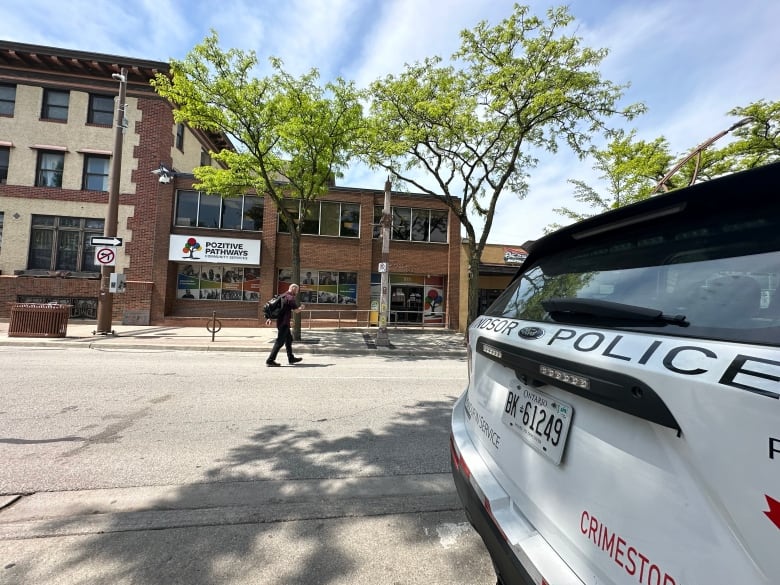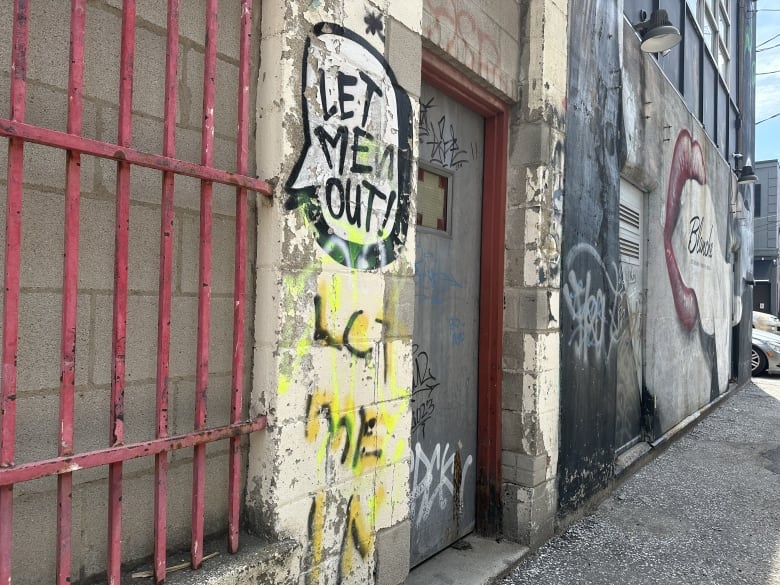On the southwest corner of Wyandotte Street and Ouellette Avenue in Windsor, Ont., Jayson Brooks points out a building’s doorways, an area where he often sees people who are homeless sleeping.
Just a few months ago, he was one of them.
Often drunk or high on cocaine, he’d huddle into the building’s crevices, away from the busy street or harsh weather, Brooks said.
“Sometimes I’d close my eyes and feel like I slept for a whole day and it’s only been for a couple hours.”
Once the drugs wore off, he was back to the “grind” of figuring out how to get his next fix.
His experiences as a drug user and someone struggling to make ends meet aren’t unusual on Windsor’s downtown streets. For years, the core of the border city has been grappling to deal with an increase in homelessness and people facing substance use and mental health challenges
They’re among issues the city’s revitalization plan, “Strengthen the Core,” hopes to address.
“I mean, of course they want to clean up downtown … but I mean what do we do with these people?” Brooks said. “They’re human beings. There’s overdoses every day. There’s people that need help.”
One part of the seven-point revitalization plan focuses on “healthy spaces,” which includes asking upper levels of government to “support wrap-around relief programs for vulnerable community members.”
You can’t just throw things in the garbage — you have to fix them.– Ashley Shepley, outreach worker
Under the plan, the city is also looking to make the streets safer by hiring more police officers, discouraging loitering and panhandling, and relocating benches away from empty businesses so people don’t stay in those areas.
But while the project aims for a shiny and new downtown, some question what this means for vulnerable individuals.

Around the same time the plan was announced, the city confirmed a new location for its Homelessness and Housing Help Hub (H4). In the next few years, the support centre will move further out of the downtown area.
And, the Downtown Mission, the city’s largest shelter, says it plans to follow suit.
The most recent statistics, from 2021, counted 251 people who were homeless on any given night in Windsor. In February, the city’s acting manager of homelessness and housing support, Kelly Goz, told CBC News there were at least 700 households facing some type of homelessness in Windsor-Essex.
City to lobby Ontario, Ottawa for supports
The city’s plan outlines multiple ways it could improve social services to better help those in need. These expansions would rely on the city seeking funding from upper levels of government as “municipal governments don’t have the fiscal capacity to solve the challenges alone.”
Key points in the plan include:
- Securing provincial funding for a “low-barrier, transitional-care facility,” for those experiencing a mental health or addictions crisis.
- Long-term provincial funding to make Windsor police’s and Windsor Regional Hospital’s nurse and police team pilot permanent and extend their hours of operation.
- Increase H4’s hours of operation, something the city has already done.
- Reduce barriers faced by people accessing H4.
- Continue to implement the strategies outlined in the city’s 10-year housing and homelessness master plan.
- There needs to better data sharing and communication between mental health and addictions service providers.
‘Overloaded with this problem’
Downtown Mission addiction counsellor Chris Thibert said “rampant” drug use is a major challenge facing the downtown.
“We’re overloaded with this problem and nobody knows what to do with it,” said the 42-year-old, who also struggled with addiction before getting sober.
Though the city’s plan, as well as other initiatives, are trying to tackle the problem, Thibert believes drug use and homelessness in the core will always exist, to some extent.
“I don’t really think it matters what you change or where you move the [Downtown] Mission or anything like that. I think the drug use is going to be here … because it’s central,” he said, adding that’s where the flow of drugs is right now.
Leaning on his own experience, Thibert said he’d like to have seen the plan focus on bringing in more social workers, outreach workers or peer support staff with lived experience.
He believes those roles would be more valuable in building relationships with people living on the streets.
Ashley Shepley, an outreach worker for four years, said she’d like a buddy system of sorts.
Shepley has been working with the Downtown Windsor Community Collaborative for more than two years and officially became their Street Light co-ordinator this month.
Her job involves meeting people around downtown Windsor and working to help them.
“Sometimes it’s just a happy ‘hello’ and sit down and chat about what they’re going to do that day; sometimes it’s a little dance in a bus stop with someone who is dancing and having a good day and twirls me around; sometimes its crisis situations; sometimes it’s an overdose,” she said.

She said she’s like to see more roles like hers. Ideally, she said, people who are vulnerable would be paired with someone who can help them get to the next phase of their life — whatever that might be.
Shepley said she isn’t so sure that more police are needed.
“I know that it does make a certain part of the community feel safe, whereas like the community that I work with … they feel [police are] more of a threat,” she said.
“Hopefully we can somehow bridge that gap.”
Who is a revitalized downtown Windsor for?
All of this begs the question: Who is this new downtown Windsor for?
“I really hope it’s for all of us,” said Shepley.
“It sounds like to me higher class is going to stay and lower class is going to go — where are they going to go? We’re all people. And like I’ve known higher-class people that have dropped to lower class, and I know lower-class people that made it high.”
Moving resources out of the downtown “hurts,” Shepley said.
These people, she said, are her community and she, like others, have spent time building that.
“Moving this group of people out of the way, you’re only going to make the other people happy,” she said.
“But we’re not understanding the domino effect that it’s going to have … you can’t just throw things in the garbage — you have to fix them.”
She feels change has been slowly happening over the last few years, as service providers are better at collaborating with each other. But she fears moving services will mean they’ll have to re-establish themselves.
Brooks said it seems the plan is being driven by the people who are “on the outside looking in.”
“They judge, they look at it and go, ‘Look at those bums —they’re acting weird,’ or whatnot. You know what I mean? But they don’t really know what’s going on,” said the 50-year-old, who moved to Windsor four years ago.
For Brooks, an ideal and revitalized downtown Windsor is a space that’s “cleaner, safer” for those struggling with addiction; it’s not one that tries to remove them from the scene altogether.
The biggest challenge is getting people on the streets to realize there are resources available to help them, he said.
But he admits the issue is so complex that he doesn’t know the answers. He does, however, believe having a space, like the H4, where people on the street can make one stop to access supports will help.
Brooks is more than three months sober — it’s the longest he’s been clean since he started using drugs three decades ago.
Living in an apartment at Wyandotte Street West and Bruce Avenue, he recently graduated from the Downtown Mission’s Phoenix recovery program and is looking for work.
“I feel fortunate that I can look at [where I used to sleep on the streets] and say, ‘I’ve rebounded,'” he said.
“It’s a bittersweet thing because when I see other people, I don’t judge and I make sure they’re OK.”



